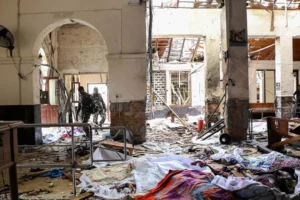One of the pleasures of the post-Cold War strategic discourses is that geopolitics is back with a bang. Earlier, the former Soviet Union and Communist China used to be in denial mode, as geopolitics didn’t fit into their Marxist-Leninist lens — although, arguably, Marx might have adapted himself a long time ago already.
The China-Central Asia Summit, which took place recently in Xi’an on May 18-19 was every bit a geopolitical event as much as the G7 summit in Hiroshima that it overlapped. The symbolism was profound. China and Russia were the elephants in the room for both summits but the Xi’an summit distinguished itself as an inclusive affair, whereas, the G7 event was, regrettably, an exclusive gathering of wealthy countries of the western world dripping with cold war-era animosities, and it didn’t hide its intentions even in its choice of “special invitees” — one ASEAN country; two BRICS countries; one tiny African state; a Pacific island etc. — borne out of the old colonial mindset of “divide and rule.”
The biggest difference was that the Xi’an summit was substantive and focused on a positive agenda that is quantifiable, while the Hiroshima summit was largely prescriptive and partly declarative and only marginally tangible. This was because the China-Central Asia summit took place on native soil while the G7 has no habitation and name in Asia except that one of the seven member countries is of Asian origin and the summit itself was a thinly-veiled attempt to insert the alien Western agenda into the Asian setting. In fact, the criterion for selecting the special invitees was itself based on the credentials of those chosen few to perform potentially as a fifth column for western interests in an Asian Century.
The China-Central Asia Summit was motivated by the growing realisation that the countries of the Eurasian region must play a proactive role in the common task of pushing back the United States, the driving force of the G7, which they perceive to be attempting to destabilise the common neighbourhood of Russia and China in Central Asia. Simply put, the Xi’an summit tacitly signalled that Russia and China are unitedly circling the wagons for a common purpose — to borrow an idiom which was employed by the Americans in the 19th century to describe a defensive manoeuvre.
From a historical perspective, it is for the first time ever that Russia and China are explicitly joining hands to stabilise the Central Asian region — a momentous happening by itself — with Beijing assuming a leadership role, given Russia’s preoccupations in Ukraine. This paradigm shift belies the western propaganda that Russian and Chinese interests collide in the Central Asian region. There is a strategic convergence between Moscow and Beijing that stability in Central Asian region, which is vital for both capitals in their own interests, is best achieved through ensuring security, boosting economic development or international political backing.
A well-known Russian think tanker at the Kremlin-funded Valdai Club in Moscow, Timofei Bordachev wrote in Global Times in the run-up to the Xi’an summit: “China and Russia are equally interested in the stability of Central Asia simply because they are directly neighbouring most of the states located in this part of Eurasia. It is as simple as the fact that you would not put on fire your neighbor’s house in order to hurt another neighbor. But if a certain power is located thousands of miles away from the common neighbourhood of Russia and China in Central Asia, it may well be betting on destabilising that region.
“The common task of China and Russia is to prevent this and make their friends and neighbours in Central Asia stable and relatively prosperous in today’s turbulent times… Whoever says that China’s and Russia’s interests in Central Asia may conflict with each other is not a friend of China, Russia or the countries of the region themselves.”
Equally, there is a consensus among the five Central Asian states to work together in a “5+1” format, which means that all crucial decisions and initiatives will be coordinated with all Central Asian states at the same time. On their part, the Central Asian partners recognise that the overall economic development of their region could get better if they strengthen their cooperation with China. Russia has played a key role here to encourage the Central Asian states to move in such a direction and play a proactive role. This itself is a marked departure as the five “Stans” have not always been able to work together, opting instead to engage with the biggest global players individually.
The participants of the Xi’an summit, which Chinese President Xi Jinping who hosted the event called a “new era” in his country’s relations with the region, agreed to create a mechanism for communication between the heads of post-Soviet states of Central Asia and China. The meetings will be held alternately every two years in the format of Central Asia – China. The next meeting of the six leaders is scheduled for 2025 in Kazakhstan. The Xi’an Declaration released after the summit includes 15 points, divided into several blocks of issues: security, logistics, trade and economic cooperation, humanitarian cooperation and ecology.
What emerges is that Beijing’s interest lies primarily in security considerations against the backdrop of the activities of extremist groups such as the Islamic State (which continues to get covert support from the US) that are operating out of Afghanistan. China’s thesis is that security is best strengthened through economic development and for that reason, therefore, the region is important from the point of view of economic cooperation and regional development — although in aggregate terms, Central Asian economic resources are nowhere near sufficient for meeting China’s needs.
Suffice to say, terrorist threats emanating from the region, posing threat to Xinjiang, are China’s main concern and Beijing is willing to openly invest its resources in the security of the region and take part in the training of the anti–terrorist forces of the Central Asian states. Geographically, three out of the five Central Asian countries, namely Kazakhstan, Kyrgyzstan, and Tajikistan, share borders with China. As for Russia, it has long regarded the region as its traditional sphere of influence and a strategic buffer zone, and thus prioritised the security of its southern border. Therefore, a safe and secure Central Asia aligns with China and Russia’s respective national interests.
In the context of the Ukraine crisis, Central Asia has emerged as a frontline for the US strategy to contain and weaken Russia. However, although Central Asian countries have adopted a neutral stance on the Ukraine situation, Russia’s influence in the region remains strong and is unlikely to be largely disrupted. Three key factors are at work here. First, Russia is seen as the provider of security and Russia’s defence capabilities continue to play a crucial role in maintaining stability in the region. Second, Central Asian states heavily depend on Russia in regard of labor migration, market access, transportation, and energy resources, and no other outside power foots the bill. Third, do not underestimate that the Russia-led Eurasian Economic Union continues to systematically build up regional economic integration.
The Xi’an Declaration talks about resisting religious extremism and attempts by external forces to impose their own rules on the region. President Xi said at the summit that Beijing is ready to help strengthen the capacity of law enforcement agencies and armed forces of the regional states, and promised to “support their independent efforts to ensure regional security and fight terrorism, as well as work with them to strengthen cybersecurity.” In addition, he said Beijing is working on the creation of a regional anti-terrorist centre in China to train the security forces of the Central Asian republics.
Source: Indian Punchline















